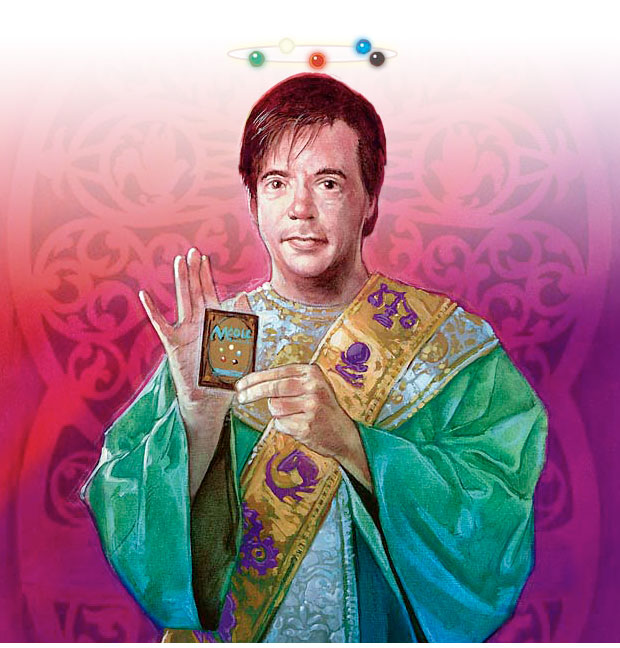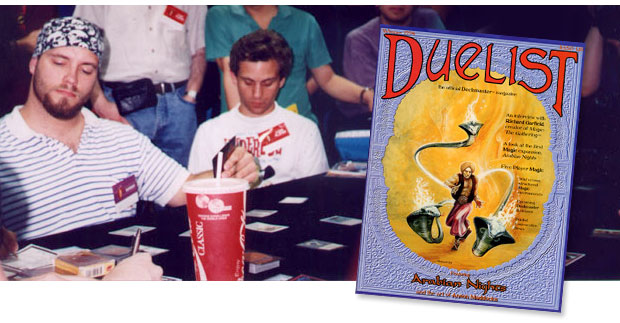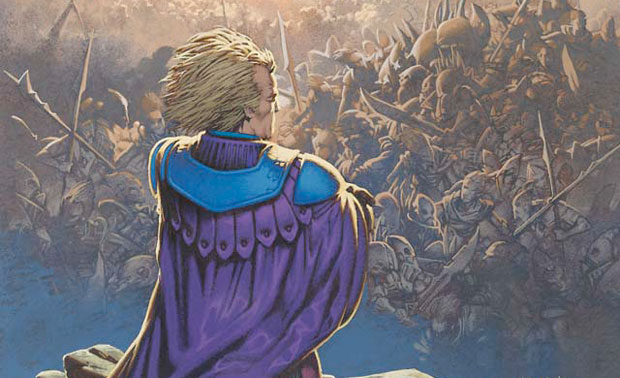Eighteen Years
Welcome to Transformation Week. This week we'll be exploring this major theme of Innistrad. I've already written on the topic of the double-faced cards, the highest profile take on transformation in the set. I thought about talking about the many other transformation mechanics we've done—flip cards, level-up, threshold, etc.—but the more I thought about them the more I got drawn in a completely different direction.
You see, today I'm going to talk about a transformation of something very key to Magic, but it isn't something you'll find on the cards. No, today's topic is about the transformation of something fundamental to the game yet something most players know very little about. My topic: the transformation of Magic Ramp;D.
- Gimme Five
I think my brain drifted to this topic because I just celebrated my sixteenth year at Wizards and in Magic Ramp;D. As I looked back, I realized that while I might be a constant, a lot has changed around me. (Also, I've grown quite a bit as a person and a designer, so I'm not sure I'm all that constant.) As I looked back over the many people to flow into and out of Magic design and development, I realized that just as the game has grown and evolved, so too has Magic Ramp;D.
Because I love putting things into boxes (mentally at least—I actually hate putting physical things into boxes, which is why I'm dreading our upcoming move where everyone trades seats in the Pit), I have grouped Ramp;D into five dynasties. Note as I talk about them that I'm going to hit upon different people.
There are too many people to hit upon everyone who has ever touched upon Magic in Ramp;D so I've decided to stick with the ones that have had the largest impact on the game. Between space constraints and my memory, I preemptively apologize to anyone I've left out.
Another interesting observation I made was that the five divisions I created for Ramp;D lined up very neatly with the five divisions I previously made when examining the history of design, what I've referred to as the Five Ages of Design. I've learned over the years that when things seem to line up neatly usually there's some correlation so as I talk about each dynasty I am going to talk about the design age that went with it.
- The First Dynasty
The original plan of Magic was simple. Richard Garfield made a game. Wizards of the Coast would produce it and sell it. Everyone knew there was a possibility that expansions might one day be made but in that day and age, expansions usually took years to happen once a game built a following. That being known, there really wasn't much need for a Magic Ramp;D. (Note that there was an Ramp;D group at the time producing role-playing games, as that's what Wizards did—and still does—before this whole Magic thing happened.)

When the initial print run sold in the matter of weeks, that plan changed quickly. Not only was Richard asked to produce Arabian Nights, Magic's first expansion, but he was told to start putting together a Magic Ramp;D team. Richard brought in Skaff Elias, Jim Lin, Dave Petty, Joel Mick, Charlie Catino and others. The common link between all these people was that they were all the original playtesters of Magic. Let me explain.
While designing Magic, Richard lived in Philadelphia, where he was a graduate student in mathematics at the University of Pennsylvania. Richard needed playtesters for the game so he used various friends he knew that were into gaming. One group of playtesters was made up of fellow graduate students in the math and physics department. This group of friends would later be dubbed the "East Coast Playtesters" and would go on to design Antiquities, Fallen Empires, Ice Age, and Alliances. The group included Skaff Elias, Jim Lin and Dave Petty. Richard made a different group of gaming friends through a local bridge club. This group would go on to design Mirage and Visions. Among this group was Joel Mick, Bill Rose, and Charlie Catino.
Remember that there was a gap between Richard designing Magic, in 1991, and it seeing print, in 1993. When Magic started taking off, Peter Adkison, one of Wizards' founders and the company's first CEO, turned to Richard to help fill Ramp;D. This earliest dynasty was mostly connected by their tie to Richard. Being that the relationship for many of them was through the University of Pennsylvania's technical colleges (several of the Bridge Group had done their undergraduate work at U Penn as well), this group was very left brained with an emphasis on math and logic. Also, this group mostly knew each other prior to working at Wizards so they came with some social structure already built in.
For each section when I get to the Design Stage I thought I'd list my description of it from my last State of Design column.
First Stage (Alpha through Alliances): This stage was about the focus on individual card design. Design decisions tended to be made on a card-by-card basis.
Early Magic was very undefined because the game was, to use a metaphor of teenage angst, "finding itself." When you trailblaze an entire new category of game, it takes some time for everyone to figure out what exactly you're about. The early Ramp;D teams were trying to create scopes bigger than the cards but, while that was being figured out, they tackled the problems a card at a time.
Note that I'm not trying to knock on them. Being the first to do anything is hard and it's clear that so much of the greatness of the game traces directly back to what was done those first few years (not to talk about the brilliance of Richard's design in the first place). The first dynasty laid the groundwork for all that was to come.
- The Second Dynasty
The majority of the first dynasty flourished at Wizards and quickly found themselves promoted beyond the daily grind of making Magic. Skaff and Jim became vice presidents, while Joel Mick became the Head Designer amp; Developer (the positions were combined back then) and eventually the Brand Manager of Magic. Magic Ramp;D needed fresh blood. The first hire was one of the playtesters that hadn't made it out west yet, Bill Rose. The rest were various people that had impressed members of Ramp;D through different means.

I, for example, had made my mark working for The Duelist, the paper magazine dedicated to Magic produced by Wizards. My writing led to various freelance projects that ultimately led to a job offer. Mike Elliott impressed Joel Mick during an encounter at a convention. William Jockusch impressed Richard by writing him a letter. All four of us were hired within a few-month window, with Bill, William, and me all starting the same month (October, 1995). Henry Stern would join a year later off of a recommendation from me. Although it would be years before he became a staple Magic playtester, Mons Johnson also started during this time.
The connection between all five of us was that we were Magic players who showed promise as game developers. Yes, even though Mike, Bill, and I would go on between us to design seventy percent of all the large expansions in Magic's history (as of today), we were all hired as developers. Most of the first dynasty were working on other projects so the five of us did almost all the development work for many years. Development teams weren't selected back then; it was just the five of us. The development team for sets was Magic Ramp;D.
This group had a little more varied background. As a result, Magic Ramp;D's skill set started to broaden. One of my big influences was a pull towards the right brain with more talk of psychological implications for decisions. This was the era of the psychographics with Timmy, Johnny, and Spike first getting defined. Also, as my statistic above showed, many of us went on to demonstrate much stronger design skills than development ones.
Which brings us to the second design wave:
Second Stage (Mirage through Prophecy): This stage was the introduction of the block and the focus of design in thinking of Magic in terms of a year.
This dynasty was responsible for probably the single biggest shift of the game. The block model and the emphasis on Limited that comes with it completely redefined what Magic, and trading card games, had to offer. (Once again, these ideas all trace back to the first dynasty.) I feel one of the strengths of this dynasty was that we each had a great love for the game but came from such different places.
- The Third Dynasty
Magic Ramp;D has made mistakes, but few compare to Urza's Saga block. It was the one and only time Magic Ramp;D has ever been brought to the CEO's office and yelled at in my entire time at the company. Urza's Saga block played up that the current batch of Ramp;D members were not what we would now call hardcore developers. We had a sense of what made the game fun, but the majority of us did not have the chops to successfully craft the proper power level of a metagame.

The result of these events is that Ramp;D started searching for new Magic Ramp;D members at the Pro Tour. By this time Bill had risen to be the Head Designer/Developer for Magic and he was looking for seasoned pro players. I recommended both Randy Buehler and Mike Donais, who Bill eventually hired. Bill ended up also hiring Brian Schneider and Worth Wollpert, who both also came from the Pro Tour. I hired Aaron Forsythe to run the Magic website based on getting to know him through the Pro Tour. (Aaron wouldn't move to Ramp;D for a few years but it was his Pro Tour chops that aided him in getting the job.)
Elaine Chase would move to Ramp;D from Organized Play, but she too had come in through the ranks of the Pro Tour. Devin Low had a lower profile Pro Tour record, but he impressed Richard and was brought on. Brian Tinsman had been working for the company in Data Research (back when we had a department dedicated to it) and moved to Ramp;D to be the Business Manager. Tyler Bielman had spent his first few years at Wizards as part of Joel Mick's Magic brand team but moved to Ramp;D to run the Creative Team. While there he was very influential in changing how we thought of block design.
This group was much more polished than the last in that they had first proven their skills outside of Wizards. Much of what is now thought of as modern development started with this group. Also, I believe it had a big impact on design as well:
Third Stage (Invasion through Saviors of Kamigawa): This stage was the introduction of block themes. Blocks were no longer just a collection of mechanics, but contained specific things chosen to highlight the block's theme.
I feel strongly that design and development bounce off of one another. As development brought up its game it inspired design to do the same. No longer were "two new mechanics" (the default for design for many years) enough. If the Limited play was going to have cohesion, so too would the entire design. The block would be about something.
- The Fourth Dynasty
Much as the Third Dynasty came about from Bill Rose's advancement, the Fourth Dynasty came about due to Randy Buehler's. Randy's reign as Director of Magic led him to get more established pros into Ramp;D. Mike Turian, Erik Lauer, and Nate Heiss (as well as Aaron Forsythe to a lesser extent) were former teammates of Randy's, and he helped bring them to Magic Ramp;D. Matt Place was another established pro—he and Randy had won their Pro Tours during the same season—and Randy welcomed him aboard when Matt expressed interest at working in Ramp;D.

Randy greenlit my wacky idea for a reality-game-like event to find more designers called The Great Designer Search. The top four—from first to fourth, Alexis Janson, Ken Nagle, Graeme Hopkins and Mark Globus—all found employment at Wizards, with Ken ending up with a full-time design job in Magic Ramp;D. Mark Globus would later become Magic Ramp;D's producer helping to bring order to Ramp;D's chaos. While Alexis and Graeme work for other sections of the company, both spend time serving on design and development teams, with Alexis currently leading "Sinker," the spring set for 2013.
Randy would also spearhead a project called Gleemax, which would bring in other talented designers to Wizards some of which ended up working on Magic, among them Paul Sottosanti and Gregory Marques. It was also during this time that Mark Gottlieb, who was hired years earlier as an editor would become the Rules Manager for Magic. Finally, Steve Warner would move from customer service to become one of Magic's strongest playtesters.
I feel one of the defining qualities of the fourth dynasty was an attention to the big picture. Magic Ramp;D had spent many years defining the basics, but this group wanted to pull back the scope. This is very clear by looking at the fourth wave:
Fourth Stage (Ravnica through Rise of the Eldrazi): This stage was the introduction of block planning. Instead of picking a theme and continuing it through the block, design now planned out how exactly the block was going to evolve. This planning allowed for themes to be better set up and paid off.
Much as the second dynasty shifted the focus from the cards to the sets, the fourth dynasty shifted the focus from the sets to the blocks. The block itself had to have an identity.
- The Fifth Dynasty
This final dynasty is the current crop of designers and developers (plus the few who remain from previous dynasties). Dave Humpherys is a Pro Tour Hall of Fame member who improved his Ramp;D skills working for another game company. Zac Hill, Tom LaPille, and Max McCall all managed to land development internships where they proved their worth to the department and were hired. (Billy Moreno and Gavin Verhey are both working to do the very same thing right now, and Tom recently made the move over to Dungeons amp; Dragons Ramp;D.) Kelly Digges dipped his toe into Ramp;D while serving as the editor-in-chief for the website and has just recently shifted over to full-time Ramp;D (half editing, half playtesting). Matt Tabak joined Ramp;D from Customer Service as an editor, then became rules manager when Mark Gottlieb switched over to full-time developer. Ethan Fleischer and Shawn Main got their foot in the door through the second Great Designer Search.

The interesting things about this last batch is that their entry into Wizards was a bit different than those that came before them. Several of them clearly had success on the Pro Tour but it was the ability to demonstrate their understanding of the inner workings of the game through things such as articles that got us their attention.
I believe a result of this is that this latest group of Ramp;D members are very interested in what the players want, not in cards but rather in concepts. The fifth dynasty, much as the design wave, is very much about resonance (an idea that Aaron pushed for very hard when creating Magic 2010), about how the overall Magic experience affects the players:
Fifth Stage (Scars of Mirrodin through ???): Now we get to last year. What I believe Scars of Mirrodin block has done that shifts design into the next age is to radically change how mechanical themes are looked at and used. For the last two stages, themes have been used as the foundation to build the block on. Starting with Scars of Mirrodin, mechanical themes are now thought of as tools used to put a block together. Metaphorically, themes are no longer the canvas, but the paint.
The latest dynasty is excited by continuing the trend of broadening the Magic experience. I believe Innistrad's success has come from all Ramp;D working together to create something that has a visceral feel as much as stimulating an intellectual curiosity. This dynasty got here by demonstrating that they understand not only what Magic currently does but what it could ultimately do. That is why I'm quite excited to see what this dynasty of Magic Ramp;D is able to do.
- Ch...Ch...Changes
I hope you've had as much fun as I've had today looking back at a very different transformation. I feel it's one just as cool as double-faced cards, even if it isn't something we talk about as much. As always, I'm curious to get your feedback on what you thought of today's article.
Join me next week when I have a flashback about flashback.
Until then, may you have the joy of working with such interesting and passionate people.



